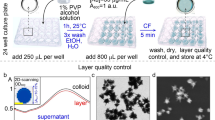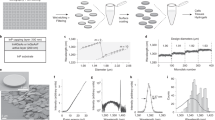Abstract
Laser-mediated gene transfection into mammalian cells has recently emerged as a powerful alternative to more traditional transfection techniques. In particular, the use of a femtosecond-pulsed laser operating in the near-infrared (NIR) region has been proven to provide single-cell selectivity, localized delivery, low toxicity and consistent performance. This approach can easily be integrated with advanced multimodal live-cell microscopy and micromanipulation techniques. The efficiency of this technique depends on an understanding by the user of both biology and physics. Therefore, in this protocol we discuss the subtleties that apply to both fields, including sample preparation, alignment and calibration of laser optics and their integration into a microscopy platform. The entire protocol takes ∼5 d to complete, from the initial setup of the femtosecond optical transfection system to the final stage of fluorescence imaging to assay for successful expression of the gene of interest.
This is a preview of subscription content, access via your institution
Access options
Subscribe to this journal
Receive 12 print issues and online access
$259.00 per year
only $21.58 per issue
Buy this article
- Purchase on Springer Link
- Instant access to full article PDF
Prices may be subject to local taxes which are calculated during checkout






Similar content being viewed by others
References
Kawabata, I., Umeda, T., Yamamoto, K. & Okabe, S. Electroporation-mediated gene transfer system applied to cultured CNS neurons. Neuroreport 15, 971–975 (2004).
O'Brien, J.A. & Lummis, S.C. Diolistic labeling of neuronal cultures and intact tissue using a hand-held gene gun. Nat. Protoc. 1, 1517–1521 (2006).
Hsu, C.Y.M. & Uludag, H. A simple and rapid nonviral approach to efficiently transfect primary tissue-derived cells using polyethylenimine. Nat. Protoc. 7, 935–945 (2012).
Naldini, L. et al. In vivo gene delivery and stable transduction of nondividing cells by a lentiviral vector. Science 272, 263–267 (1996).
Zhang, Y. & Yu, L.C. Microinjection as a tool of mechanical delivery. Curr. Opin. Biotech. 19, 506–510 (2008).
Hewapathirane, D.S. & Haas, K. Single cell electroporation in vivo within the intact developing brain. JoVE 17, e705 (2008).
Judkewitz, B., Rizzi, M., Kitamura, K. & Hausser, M. Targeted single-cell electroporation of mammalian neurons in vivo. Nat. Protoc. 4, 862–869 (2009).
Stevenson, D.J., Gunn-Moore, F.J., Campbell, P. & Dholakia, K. Single cell optical transfection. J. R. Soc. Interface 7, 863–871 (2010).
Hosokawa, Y. et al. Gene delivery process in a single animal cell after femtosecond laser microinjection. Appl. Surf. Sci. 255, 9880–9884 (2009).
Hosokawa, Y., Ochi, H., Iino, T., Hiraoka, A. & Tanaka, M. Photoporation of biomolecules into single cells in living vertebrate embryos induced by a femtosecond laser amplifier. PLoS ONE 6, e27677 (2011).
König, K. et al. Sub-100 nm material processing and imaging with a sub-15 femtosecond laser scanning microscope. J. Laser Appl. 24, 042009 (2012).
Uchugonova, A. et al. Nanosurgery of cells and chromosomes using near-infrared twelve-femtosecond laser pulses. J. Biomed. Opt. 17, 101502 (2012).
Uchugonova, A., Koenig, K., Bueckle, R., Isemann, A. & Tempea, G. Targeted transfection of stem cells with sub-20 femtosecond laser pulses. Opt. Express 16, 9357–9364 (2008).
Rudhall, A.P. et al. Exploring the ultrashort pulse laser parameter space for membrane permeabilisation in mammalian cells. Sci. Rep. 2, 858 (2012).
Vogel, A., Noack, J., Huttman, G. & Paltauf, G. Mechanisms of femtosecond laser nanosurgery of cells and tissues. Appl. Phys. B-Lasers O. 81, 1015–1047 (2005).
Steinmeyer, J.D. et al. Construction of a femtosecond laser microsurgery system. Nat. Protoc. 5, 395–407 (2010).
Tirlapur, U.K. & König, K. Targeted transfection by femtosecond laser. Nature 418, 290–291 (2002).
Koenig, K. & Tirlapur, U.K. Method for transferring molecules in vital cells by means of laser beams and arrangement for carrying out said method. US Patent 7,892,837 (2011).
Mthunzi, P., Dholakia, K. & Gunn-Moore, F. Photo-transfection of mammalian cells using femtosecond laser pulses: optimisation and applicability to stem cell differentiation. J. Biomed. Opt. 15, 041507 (2010).
Kohli, V. et al. An alternative method for delivering exogenous material into developing zebrafish embryos. Biotechnol. Bioeng. 98, 1230–1241 (2007).
Gu, L. & Mohanty, S.K. Targeted microinjection into cells and retina using optoporation. J. Biomed. Opt. 16, 128003 (2011).
Barrett, L.E. et al. Region-directed phototransfection reveals the functional significance of a dendritically synthesized transcription factor. Nat. Methods 3, 455–460 (2006).
Sul, J.-Y. et al. Transcriptome transfer produces a predictable cellular phenotype. Proc. Natl. Acad. Sci. USA 106, 7624–7629 (2009).
Zeira, E. et al. Femtosecond laser: a new intradermal DNA delivery method for efficient, long-term gene expression and genetic immunization. FASEB J. 21, 3522–3533 (2007).
Zeira, E. et al. Femtosecond infrared laser—an efficient and safe in vivo gene delivery system for prolonged expression. Mol. Ther. 8, 342–350 (2003).
Torres-Mapa, M.L. et al. Integrated holographic system for all-optical manipulation of developing embryos. Biomed. Opt. Express 2, 1564–1575 (2011).
Antkowiak, M., Torres-Mapa, M.L., Gunn-Moore, F. & Dholakia, K. Application of dynamic diffractive optics for enhanced femtosecond laser based cell transfection. J. Biophotonics 3, 696–705 (2010).
Baumgart, J. et al. Quantified femtosecond laser based opto-perforation of living GFSHR-17 and MTH53 a cells. Opt. Express 16, 3021–3031 (2008).
Tirlapur, U.K., König, K., Peuckert, C., Krieg, R. & Halbhuber, K.J. Femtosecond near-infrared laser pulses elicit generation of reactive oxygen species in mammalian cells leading to apoptosis-like death. Exp. Cell Res. 263, 88–97 (2001).
Lei, M., Xu, H., Yang, H. & Yao, B. Femtosecond laser-assisted microinjection into living neurons. J. Neurosci. Meth. 174, 215–218 (2008).
Marchington, R.F., Arita, Y., Tsampoula, X., Gunn-Moore, F.J. & Dholakia, K. Optical injection of mammalian cells using a microfluidic platform. Biomed. Opt. Express 1, 527–536 (2010).
Rendall, H.A. et al. High-throughput optical injection of mammalian cells using a Bessel light beam. Lab Chip 12, 4816–4820 (2012).
Foldes-Papp, Z. et al. Trafficking of mature miRNA-122 into the nucleus of live liver cells. Curr. Pharm. Biotechnol. 10, 569–578 (2009).
Peng, C., Palazzo, R.E. & Wilke, I. Laser intensity dependence of femtosecond near-infrared optoinjection. Phys. Rev. E 75, 041903 (2007).
Stracke, F., Rieman, I. & König, K. Optical nanoinjection of macromolecules into vital cells. J. Photoch. Photobio. B 81, 136–142 (2005).
Kohli, V., Acker, J.P. & Elezzabi, A.Y. Reversible permeabilization using high-intensity femtosecond laser pulses: Applications to biopreservation. Biotechnol. Bioeng. 92, 889–899 (2005).
Brown, C.T.A. et al. Enhanced operation of femtosecond lasers and applications in cell transfection. J. Biophotonics 1, 183–199 (2008).
McDougall, C., Stevenson, D.J., Brown, C.T.A., Gunn-Moore, F. & Dholakia, K. Targeted optical injection of gold nanoparticles into single mammalian cells. J. Biophotonics 2, 736–743 (2009).
Tsampoula, X. et al. Fibre based cellular transfection. Opt. Express 16, 17007–17013 (2008).
Ma, N., Ashok, P.C., Stevenson, D.J., Gunn-Moore, F.J. & Dholakia, K. Integrated optical transfection system using a microlens fiber combined with microfluidic gene delivery. Biomed. Opt. Express 1, 694–705 (2010).
Ma, N., Gunn-Moore, F. & Dholakia, K. Optical transfection using an endoscope-like system. J. Biomed. Opt. 16, 401–407 (2011).
Terakawa, M. & Tanaka, Y. Dielectric microsphere mediated transfection using a femtosecond laser. Opt. Lett. 36, 2877–2879 (2011).
Terakawa, M., Tsunoi, Y. & Mitsuhashi, T. In vitro perforation of human epithelial carcinoma cell with antibody-conjugated biodegradable microspheres illuminated by a single 80 femtosecond near-infrared laser pulse. Int. J. Nanomed. 7, 2653–2666 (2012).
Chakravarty, P., Qian, W., El-Sayed, M.A. & Prausnitz, M.R. Delivery of molecules into cells using carbon nanoparticles activated by femtosecond laser pulses. Nat. Nanotechnol. 5, 607–611 (2010).
Baumgart, J. et al. Off-resonance plasmonic enhanced femtosecond laser optoporation and transfection of cancer cells. Biomaterials 33, 2345–2350 (2012).
Kuetemeyer, K., Baumgart, J., Lubatschowski, H. & Heisterkamp, A. Repetition rate dependency of low-density plasma effects during femtosecond-laser-based surgery of biological tissue. Appl. Phys. B-Lasers O. 97, 695–699 (2009).
Svoboda, K. & Block, S.M. Biological applications of optical forces. Annu. Rev. Biophys. Biomol. Struct. 23, 247–285 (1994).
Lee, W.M., Reece, P.J., Marchington, R.F., Metzger, N.K. & Dholakia, K. Construction and calibration of an optical trap on a fluorescence optical microscope. Nat. Protoc. 2, 3226–3238 (2007).
Čiz`már, T. et al. Generation of multiple Bessel beams for a biophotonics workstation. Opt. Express 16, 14024–14035 (2008).
Tsampoula, X. et al. Femtosecond cellular transfection using a nondiffracting light beam. Appl. Phys. Lett. 91, 053902 (2007).
Brunner, S. et al. Cell cycle dependence of gene transfer by lipoplex polyplex and recombinant adenovirus. Gene Ther. 7, 401–407 (2000).
Lechardeur, D. et al. Metabolic instability of plasmid DNA in the cytosol: a potential barrier to gene transfer. Gene Ther. 6, 482–497 (1999).
von Kockritz-Blickwede, M., Chow, O.A. & Nizet, V. Fetal calf serum contains heat-stable nucleases that degrade neutrophil extracellular traps. Blood 114, 5245–5246 (2009).
Praveen, B.B., Stevenson, D.J., Antkowiak, M., Dholakia, K. & Gunn-Moore, F.J. Enhancement and optimization of plasmid expression in femtosecond optical transfection. J. Biophotonics 4, 229–235 (2011).
Stevenson, D. et al. Femtosecond optical transfection of cells: viability and efficiency. Opt. Express 14, 7125–7133 (2006).
König, K., Riemann, I., Stracke, F. & Le Harzic, R. Nanoprocessing with nanojoule near-infrared femtosecond laser pulses. Med. Laser Appl. 20, 169–184 (2005).
Arlt, J., Dholakia, K., Soneson, J. & Wright, E.M. Optical dipole traps and atomic waveguides based on Bessel light beams. Phys. Rev. A 63, 063602 (2001).
Čiz`már, T. & Dholakia, K. Tunable Bessel light modes: engineering the axial propagation. Opt. Express 17, 15558–15570 (2009).
Arlt, J., Garces-Chavez, V., Sibbett, W. & Dholakia, K. Optical micromanipulation using a Bessel light beam. Opt. Commun. 197, 239–245 (2001).
Tsukakoshi, M., Kurata, S., Nomiya, Y., Ikawa, Y. & Kasuya, T. A novel method of DNA transfection by laser microbeam cell surgery. Appl. Phys. B-Photo. 35, 135–140 (1984).
Acknowledgements
This work is supported by the UK Engineering Physical Sciences Research Council (EPSRC). We would like to acknowledge Roslin Cellab for providing the human embryonic stem cells through a SUPA start-up grant. M.A. acknowledges the support of an EPSRC-funded 'Rising Star' Fellowship and the SULSA. K.D. is a Royal Society Wolfson Merit Award holder. F.J.G.-M. acknowledges the support of the R.S. MacDonald Charitable Trust, SU2P and The 'BRAINS' 600th anniversary appeal. Both K.D. and F.J.G.-M. acknowledge the support of E. Killick. We are grateful to all current and past members of the Biophotonics group at University of St. Andrews who contributed to the development and optimization of this protocol.
Author information
Authors and Affiliations
Contributions
M.A. and M.L.T.-M. obtained the results reported in the protocol and wrote the manuscript. M.A., M.L.T.-M., D.J.S., K.D. and F.J.G.-M. edited and approved the manuscript. K.D. and F.J.G.-M. led the project.
Corresponding authors
Ethics declarations
Competing interests
The authors declare no competing financial interests.
Supplementary information
Supplementary Video 1
Examples of transient gas bubbles formed on cellular membrane. Left: a long-lasting bubble indicates an irradiation overdose. Right: a small (<2 μm) bubble indicates good beam alignment and correct irradiation parameters. (AVI 11528 kb)
Rights and permissions
About this article
Cite this article
Antkowiak, M., Torres-Mapa, M., Stevenson, D. et al. Femtosecond optical transfection of individual mammalian cells. Nat Protoc 8, 1216–1233 (2013). https://doi.org/10.1038/nprot.2013.071
Published:
Issue Date:
DOI: https://doi.org/10.1038/nprot.2013.071
This article is cited by
-
Interferometric and fluorescence analysis of shock wave effects on cell membrane
Communications Physics (2020)
-
Magnetic Force-driven in Situ Selective Intracellular Delivery
Scientific Reports (2018)
-
Exosomal cargo including microRNA regulates sensory neuron to macrophage communication after nerve trauma
Nature Communications (2017)
-
Oxidative Stress Alters the Morphological Responses of Myoblasts to Single-Site Membrane Photoporation
Cellular and Molecular Bioengineering (2017)
-
Single Cell Transfection through Precise Microinjection with Quantitatively Controlled Injection Volumes
Scientific Reports (2016)
Comments
By submitting a comment you agree to abide by our Terms and Community Guidelines. If you find something abusive or that does not comply with our terms or guidelines please flag it as inappropriate.



